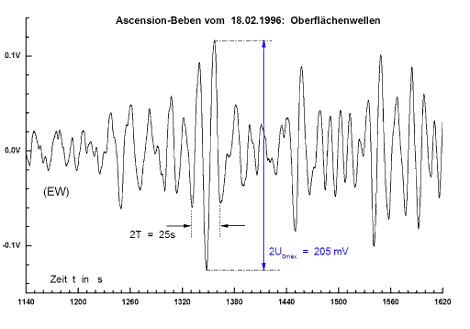6.2 Magnitude
As mentioned above the technical term for the strength of an earthquake is "Magnitude". The media usually refer to the "position on the Richter scale". - We determine the magnitude from that surface wave with the largest amplitude. The magnitude determined by this method is called "Ms-Magnitude", (s = surface).
Our seismogram shows that the largest signal of the Rayleigh-surface wave has got double the amplitude of 205 millivolts. From this amplitude belonging to the period T the corresponding displacement of ground a o can be calculated in the same manner as described in the previous chapter : with Uo= 205 mV and a period T = 12,5s a ground-displacement with an amplitude of about ao = 38�m can be stated, i.e. 3.8 hundredth of a millimetre.
International experts have agreed on a formula for calculating the Ms-Magnitude of an earthquake; therefore you need:
- the largest ground-displacement a0 in the surface waves
- the corresponding period T of the movement
- the distance Δ to the epicentre
From this formula released from IASPEI (International
Association of Seismology and Physics of the Earth's Interior)

we finally get the result Ms = 6.7 . The value published
by NEIS is in this case 0.4 smaller. - Even in professional seismographic
observatories differences in magnitude up to 1 occur if one compares
the data of the single stations. So we remain within those limits.
